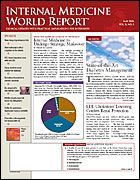Publication
Article
Internal Medicine World Report
Obesity in America: More Bad News on National Trends
Author(s):
More children and adolescents are now overweight and more men are now obese than at any other time in the history of the United States. About the only “good” news to come from the latest national estimates is that the prevalence of obesity in women appears to have reached a plateau during the past 6 years.
JAMA
A recently published study (. 2006;295:1549-1555) reports the results of an analysis of height and weight measurements from almost 4000 children and adolescents and 4431 adults who participated in the most recent 2003-2004 National Health and Nutrition Examination Survey (NHANES) compared with previous NHANES data (from 1999-2000 and 2001-2000). NHANES is a representative sample of the US population.
Investigators defined overweight in children as a sex-specific body mass index (BMI) at or above the 95th percentile for age growth charts. In adults, a BMI ≥30 kg/m2 qualified as obesity and a BMI ≥40 kg/m2 as extreme obesity.
Between 1999-2000 and 2003-2004, the prevalence of overweight rose by 2.2% in girls (from 13.8% to 16.0%) and by 4.2% in boys (from 14.0% to 18.2%).
The latest NHANES data indicate that about two thirds of American adults aged ≥20 years are either overweight or obese. Between 1999-2000 and 2003-2004, the prevalence of obesity increased significantly in men, from 27.5% to 31.1%. But among women, the prevalence of obesity demonstrated a slight decline, from 33.4% to 33.2% (Figure).
This gender trend flip-flopped, however, when considering only extremely obese adults. In men, the prevalence of extreme obesity decreased from 3.1% in 1999-2000 to 2.8% in 2003-2004, while in women, it increased from 6.3% to 6.9%.
Nevertheless, “multivariable model results indicate that the only statistically significant trends were those noted overall for men and for children and adolescents,” Cynthia L. Ogden, PhD, National Center for Health Statistics, Centers for Disease Control and Prevention, Hyattsville, Md, and colleagues write.
The racial and ethnic trends noted in earlier NHANES data continued with the latest data. During the entire 6-year period, there were significant racial/ethnic differences in the prevalence of obesity among women but not among men. For example, compared with a non-Hispanic white woman, a non-Hispanic black woman was more than twice as likely to be obese. Among women aged 40 to 59 years, nearly 58% of non-Hispanic blacks are obese compared with roughly 38% of non-Hispanic whites. There were, however, intra-racial differences. The rate of obesity was about twice as high among non-Hispanic black women as among their non-Hispanic black male counterparts.
Age also plays a prominent role. Data from all 3 NHANES periods show that men aged 40 to 79 years are more than twice as likely to be obese as men aged 20 to 39 years or aged ≥80 years. And nearly 3 times as many women aged 40 to 79 years are obese compared with women aged 20 to 39 years or aged ≥80 years.





